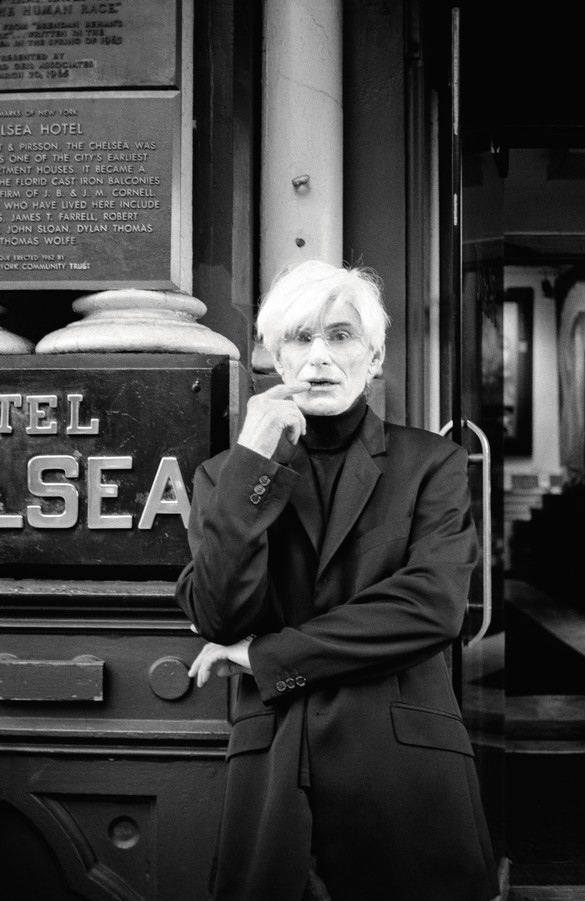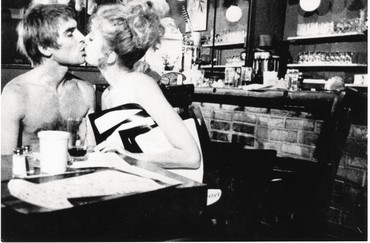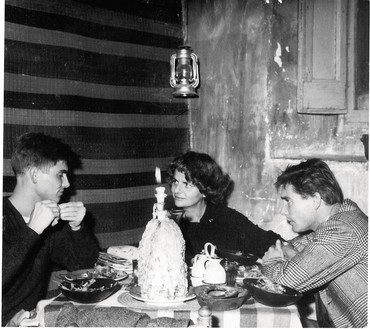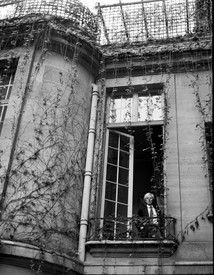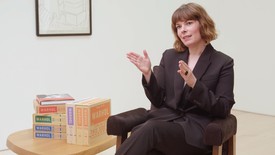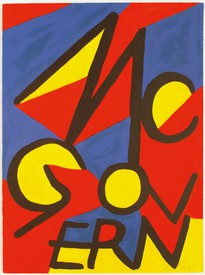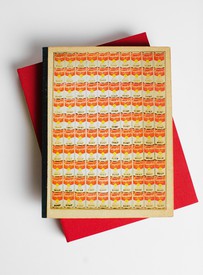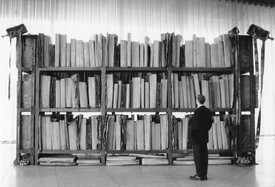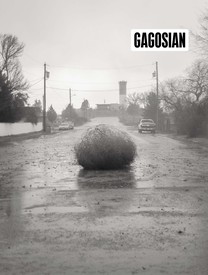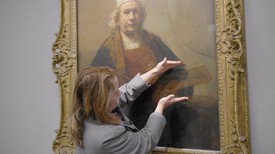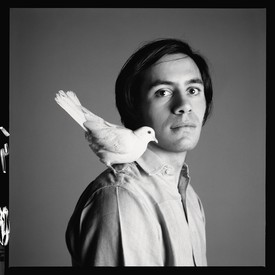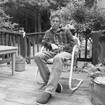
Raymond Foye is a contributing editor to the Brooklyn Rail. His most recent publication is Harry Smith: The Naropa Lectures 1989–1991 (2023). Photo: Amy Grantham
In 1967, when Andy Warhol hired the actor Allen Midgette to impersonate him on a lecture tour of America, he effectuated one of the great Dadaist acts of the twentieth century. It remains a captivating gesture to this day, an enduring work of performance art that engaged so many potent subjects in Warhol’s life and art: identity, fame, originality, artifice. An exquisitely subversive maneuver that played upon the public’s projections and expectations, it also reinforced the long-held popular view of modern art as a swindle and a hoax.
Art historians and critics have endlessly analyzed the implications of this act.1 Indeed, one of the keys to Warhol’s artistic longevity is his skill in conjuring ideas and images that remain open to a wide range of interpretations and debate. Ambivalence and ambiguity are built into his work from the start, and we are always left with far more questions than answers.
For Warhol, the creative image did not stop at the edge of the canvas. It extended into the public sphere through media of all sorts, and one can see the lecture hoax as one more aspect of that concept. Perhaps critic Wayne Koestenbaum went farthest when he wrote, “Warhol savored the sexual dimensions of substitutions: casting Allen Midgette’s body in the Andy role, and watching the replacement occur, was . . . an erotic act.”2 As we will see in this interview, that interpretation may not be as far-fetched as it seems.
Not since Baudelaire had creative irony been so wickedly employed against the public.
Raymond Foye
When eventually found out, Warhol’s act met great hostility, with audience members and venues demanding refunds. Despite these threats, though, none of the institutions pursued legal action in the end, and no refunds were given. One official from the University of Utah, Salt Lake City, traveled to New York to meet Warhol for a scheduled appointment, but the artist did not show up. When finally confronted by the Utah press, Warhol remarked, “Because I really don’t have that much to say, he was better than I am. He was what people expected.”3 Warhol’s assistant Paul Morrissey told the same reporter, “Andy Warhol thought that his substitute would be better for public consumption. Like a person that was younger and better looking and better spoken. He used the medium of the lecture circuit you might say, in an original way.”4 Rather than assuaging the wounds, these remarks only further galled. Not since Baudelaire had creative irony been so wickedly employed against the public.
It was a put-on—that classic product of 1960s culture, a tool for dividing hip from square. Figures such as Warhol and Bob Dylan carried it to a level of fine art, as evidenced in D. A. Pennebaker’s film Don’t Look Back (1967), where the Dylan of 1965 surgically dismembers reporters looking to promulgate stereotypes.5 Warhol’s method with the press was more passive aggressive, with the favored mode being an arch ennui. But the results are the same in both cases: exposing the media’s games of manipulation and commodification, and their penchant for slapping simplistic labels on new and complex ideas.
Before performing in a dozen or more Warhol films, including The Nude Restaurant (1967), **** (Four Stars) (1967), and Lonesome Cowboys (1968), Midgette appeared in numerous classic Italian films, including Pier Paolo Pasolini’s La Ricotta (1963) and Bernardo Bertolucci’s The Grim Reaper (1962) and Before the Revolution (1964). In the 1970s he continued to work in Europe, with Bertolucci in The Spider’s Stratagem (1970) and 1900 (1976) and with Jean-Luc Godard in Le vent d’est (1970). But his impersonation of Warhol on the 1967 lecture tour was surely his strangest role. Although this tour has been frequently discussed, the story has seldom been told by its major participant.
Now eighty-two, Midgette lives in a second-floor apartment/workshop in the village of Woodstock, New York, which he has hand-painted from floor to ceiling. The space is filled with his leatherwork, original T-shirts, and jewelry designs.
Raymond Foye Explain to me how this caper began.
Allen Midgette It was one of those things that nobody was totally responsible for, in terms of knowing where it would go or what it would do in the culture. It was just a normal evening, me going into Max’s Kansas City late at night, looking for something to do. I ran into Paul Morrissey and he invited me to have a drink, which was highly unusual because we weren’t friends—we weren’t enemies, we worked together at the Factory where I was in films, but we were not close buddies. Now Paul was not somebody to throw down money for drinks for drug trash, which is what he called me and the other actors. Also I knew something was weird because he had this black leather jacket with him. We got the drinks and he said, “Do you want to go to Rochester tomorrow to impersonate Andy?” And I said, “No, why would I?” He said, “You get paid.” It was about $600, which was a lot of money for me in those days. He said I’d be showing a movie. I knew Andy well enough to know I didn’t have to worry about talking too much, because he didn’t. And I knew I could deal with people much more easily than he could, because I did.
RF That’s what Andy said when he got caught: “I knew he’d be much better at being me than I would.”
AMThat was the way I felt. Anyway it was decided that I would do it. So Paul asked me to spend the night at his house because he was afraid I wouldn’t get up in the morning. We went to his house on 10th Street and I slept in the living room. I woke up before dawn when I heard a knock on the door. They say, “Hey Paul, it’s your friends.” Now, that’s the kind of thing you don’t hear in New York, ever. People don’t say that, and it didn’t sound very friendly. So I thought, It’s not my house, I’m not answering. I saw Paul stumble out of his bedroom with his eyes half shut. He opens the door and these three guys walk in who are obviously narcs, and they want to talk. I pretend I’m still sleeping and suddenly they’re shaking me and shining a flashlight in my face and saying, “Wake up! Have you ever taken LSD?” And I said, “No sir, and neither has my friend Paul.” I knew Paul never took drugs so I was relaxed about that. The narcs go around the apartment and come up empty handed. Finally they find a Velvet Underground album and they find the song called “Heroin” and they’re pointing to it, saying, “Look at this!” I said, “Yeah, but it’s just a song.” I think they came there because Paul had had to go downtown to bail so many of the performers in Andy’s films out of jail. Probably they thought he was the dealer. Finally they left. It gave me pause for a minute: should I do what I’m doing, is this an omen? I decided to throw the I Ching and it said something like, “Everything acts to further.” I wasn’t sure what that meant but I decided to go ahead. The next thing I know we’re in a taxi. First to the Factory to pick up the film.
What I did get to see was what it’s like to be someone important, because that person wasn’t me at all.
Allen Midgette
RF At this point you had to be thinking about the role a little bit?
AM Mostly I was thinking I needed makeup. We stopped at a pharmacy and I bought a compact with a little mirror, and I started doing the makeup thing in the back of the taxi. I wanted to make my skin look much lighter. I also bought silver spray and talcum powder for my hair. We got to the Factory and we woke up Billy Name. I was wearing the black leather jacket, black jeans, sunglasses: for a minute he thought I was Andy. That was funny, and encouraging—I realized this might actually work. Then we got to the airport and nobody wanted to get near me, and in those days the stewardesses were usually very friendly. I was wearing a huge amount of patchouli oil, purposely to throw people off. It was all about confusing people. I chewed gum, for instance, because it also doesn’t let people see you for yourself, you’re just a person chewing gum. I did whatever I could think of like that—that’s how you work as an actor, you use whatever’s available to you.
Eventually we got to the Rochester Institute of Technology and even there, people were still staying away. It was what I was hoping for. I put them on guard, which Andy really did—that was his passive-aggressive nature. And let’s face it, it’s easy to forget that back then, Andy was a really strange-looking dude. I think most people saw him as a very unattractive person. It’s funny what fame does to people, it makes it harder to imagine the real person. I don’t like to get too psychological, but what I did get to see was what it’s like to be someone important, because that person wasn’t me at all. I got to see other people’s behavior, because I was wearing dark glasses, too, so I could look at them.
RF Paul Morrissey was with you the whole time?
AM He had to be. He was the straight man and he had to show the film. He had his job, to be sure, which was to legitimize why we were even there. Because if they spoke to me, I couldn’t have told them anything. I really didn’t know what was happening and I didn’t really care.
We finally arrived at the gym where we were going to do the event. Paul set up the projector to show the movie first, and I realized I didn’t have to be there, so I went to the other side of the screen and sat in a chair with my back to the audience, because it kept me from being involved with them.
RF What was the movie?
AM It was a commercial for Bufferin, an aspirin product. What I was told was, the Grey Advertising agency gave different artists money to make a film to see if it could use one of them, which of course it couldn’t. So this was the one Andy made, with all these people talking about Bufferin, saying things like “I smoked Bufferin for quite a few years,” or whatever kind of thing they said in those movies. So I’m seeing the film for the first time from behind the screen and trying to figure out what I’m going to be talking about with all these people. I thought, “Hmm, this is interesting … ”
RF Then you took questions from the audience. How did that go?
AM The first question was “Mr. Warhol, why do you wear so much makeup?” And I said, “Oh, I have a skin condition.” And the next question was “Mr. Warhol, are you gay?” And I just said no. It came out so easy because in that respect I didn’t want to speak for anyone, and it was perfect because the whole audience went silent for a minute. Then somebody asked me about my formal training and I had no idea. Fortunately the young man from the school standing onstage with me, directing who could ask questions from the audience, said, “Oh don’t ask that, that’s on the brochure.” So he saved my ass on that one. The one thing I knew about Andy was, you could answer any question anyway you liked and it would be fine. It might not have been the same thing he would say, but it would make as much sense. I think they gave us $1,200 for the event. We went back to New York the same day. That was the most normal of the events. Later on things got a lot stranger and people got testy.
RF When you got back to New York, did Andy ask you how it went?
AM No, we never spoke about it, ever.
RF Never?
AM Never. I thought that was the end of it. It was 1967, the Summer of Love—I wanted to get out of New York and go to Haight-Ashbury. I got there and loved it, I lived on the streets for a few months, and then the scene started changing, heroin started moving in and things got weird. I wanted to get out of there and come back to New York, so I called up the Factory to see if they could send me a ticket, which I usually didn’t ask for. Paul Morrissey answered the phone and said, “I can’t believe it, we were just talking about you. We want you to go out on a tour of three more colleges.” So I said fine and they sent me the ticket. This time it was all planned out: first it was Salt Lake City, then Eugene, Oregon, then Bozeman, Montana. The events were in the evenings and I wouldn’t go out in the daytime. Also I was carrying grass all the time, if I’d gotten busted I’d have been sent to prison for twenty years.
In Salt Lake City it was a huge crowd in a large theater, not a gym. They used a Nico recording to lead into the whole thing. The film may have changed, I can’t remember—I think we were showing some reels from Twenty-Four-Hour Movie [**** (Four Stars)]. For the Q&A I could always just fall back on being as silly as Andy was. You could tell from the questions they didn’t really know who he was, all their information was wrong.
RF I recall Henry Geldzahler once telling me that his brother David went to the event in Salt Lake City. He was a lawyer and he had helped Andy buy his first studio in New York, a firehouse. He called Henry in New York from a pay phone in the theater all upset, saying, “There’s a guy here who’s saying he’s Andy Warhol!” And Henry said, “We know, we know, be quiet!”
AM That’s funny, I never knew that. This all became about identity. A lot of people like to pretend that Andy and I were doppelgängers; no, it’s about acting. In Eugene I met someone who knew Andy and had been to the Factory a couple of times, but he didn’t get it either. It made me realize how, in life, people just presume a lot of things. Just because you’ve met Andy twice, does it mean you remember exactly how he looked, and how he would look under different circumstances? If you’re being told it’s Andy and everyone else is accepting it, you’ll go along with that. It shows you how people just aren’t very curious about what’s in front of them. And the fact that you’re a famous person means they don’t really see you, they’re just seeing their own projection of you. At one point I was herded in and trapped in a corridor with about twenty people wanting to get to me to get an autograph. It was strange to see what it was like to be famous. And Andy wasn’t that famous back then, I don’t think—he was famous in the art world, but that was a very small world. You couldn’t mention his name in Sheboygan. Nobody in Tampa would know him. He wasn’t known in your family. Now, even people who don’t know Andy Warhol know Andy Warhol—the fact that he’s famous, that’s enough for them.
I didn’t even know what movies were after I worked for Andy Warhol.
Allen Midgette
By Eugene, Oregon, I’d loosened up a bit more. I remember going to a party and signing a lot of draft cards; the students liked me. I would talk about weird things like astrology. I don’t think people had a grasp on Andy yet, in terms of his art—I’m sure there were some students who got him but it was more about the feeling of notoriety. Word was out that Andy was kooky, that was expected. In Bozeman I got along really well with the students. They took me around and showed me apartments and studio spaces, they wanted me to move there. Can you imagine, Andy moving to Bozeman in 1967? It was so unreal. But see, this is the difference: Andy would never have gotten that reaction from anybody. They might have liked him but they wouldn’t have felt friendly toward him. He wouldn’t have known how to put them at ease at all. I was more like them already. I really think Andy sent me out for that reason. I don’t think Andy could give a lecture, do you?
RF No, absolutely not.
Prior to Andy you’d been directed by Pasolini and Bertolucci and you were an extra in the film West Side Story (1961). How did the movie experience with Andy differ?
AM I didn’t even know what the movies were after I worked for Andy Warhol. I gave up on the very idea after that.
RF They were largely improvised?
AM You couldn’t even call it improvisation. There was no theme whatsoever in those films, they were just reactive. Improvisation involves an agreement between all players, it isn’t something where each person is improvising on their own, that doesn’t work. You have to improvise together or you’re not improvising, you’re just competing, you see what I mean? And that’s what I found was happening at the Factory. People did a lot of drugs, heavy-duty drugs. Some of the people you had to perform with were interested in performing but not in the normal sense of performing. And they were usually angry with each other about something that happened the day before, like some drug deal gone bad, and suddenly I’m the middle of it. It was like improvising in a jail cell, there was only so far you could go. Also, they were all deeply involved in the scene already, and I always considered myself an outsider at the Factory. Do you know how I actually met Andy?
RF No, I would love to know.
AM That’s an important part of this whole mad saga of the lecture tour, this absurdity. Before the Revolution came out in 1964 and by early 1965 I was back in Los Angeles, looking for acting work. But in LA, I always give up the idea of being an actor, there’s something about that place that just does that to me. So I got back to New York, I needed a job, and some friend of mine—maybe Johnny Nicholson from Café Nicholson, or it could have been Jerome Robbins—they told me that I could go interview for a job at the discotheque Arthur. It was run by Richard Burton’s ex-wife Sybil Christopher and her husband Jordan Christopher, the lead singer in the band the Wild Ones. I interviewed for a waiter’s job, which was a good gig—you could make as much as $400 a night, and that was good pay in those days. But you had to be on spot. There was a dancing thing where you had to move to the music when you weren’t waiting on tables, which was fine. So anyway I started working there. I didn’t really like it, to be honest. I liked the idea that I was working and making money to pay bills, but it wasn’t really a scene I wanted to be involved with.
Then this guy David Croland—later he was Robert Mapplethorpe’s boyfriend but at the time he was going out with a model named Susan Bottomly, who went by the name of International Velvet in Andy’s films—and he brought her to Arthur. She was about seventeen and a very beautiful girl, she’d already been on the cover of Mademoiselle, and she really liked me. We danced together and she said, “You have to come meet Andy Warhol, he would love you and you could be in his movies.” And I said, “Oh, that’s all right,” because I had friends who had worked with Andy who weren’t so keen on him. Andy wasn’t the kind of person I was anxious to hang with. I might also have been overserious about being an actor, but that’s the way I was then. One day I get to work in the late afternoon, the place is empty, and my boss comes up to me and says, “Andy’s here and he wants to talk to you.” So I go over and Andy is sitting by himself—and I never saw Andy by himself again, but there he was, sitting alone, like some strange painting in the corner. I walk over and he immediately says, “Oh you’re so fabulous, blah blah blah, we’d like you to be in our movies.” And I said, “I’m really not interested in movies right now.” I told him my idea of making movies would be, you get a group of people together and you make a bond between all of you to stay together for ten years and you very slowly just get used to being in front of the camera, you don’t even try to do anything else, you just get used to being in front of the damn camera and you slowly build up this rapport. And Andy said, “Oh, that’s what we’re trying to do,” but I knew he was bullshitting me.
RFWhere did you get that concept from, the theater?
AM That style of working is what I saw on set with Pasolini. The novelist Elsa Morante was my best friend in Rome. She introduced me to everyone—Luchino Visconti, Federico Fellini, Vittorio De Sica, Luigi Comencini, Damiano Damiani, the whole scene. And Pasolini definitely had the best directing style I’d ever seen. First of all, like Robert Bresson, he didn’t use professional actors. That’s a big plus right away, because professional actors do too much acting. With Pasolini, everyone had their job to do and everyone made a contribution, it was like a big family.
RF Had Andy seen you in films?
AM I don’t know. When I met Henry Geldzahler the first thing he said to me was “I’ve seen Before the Revolution thirty-five times.” I knew he hadn’t seen it that many times, but he’d seen it a lot, so I assume Andy had too. To be honest, one thing I always wondered about was the way my character looked in that film and the style Andy came to adopt. Bertolucci blew my hair out and dyed it silver—if you look at a film still the resemblance is uncanny. Anyway, I left Andy kind of not knowing. I didn’t say I was interested but I didn’t say I wasn’t. He gave me his telephone number.
RF Then what happened?
AM Well, first he invited me out on what I later realized was probably a failed attempt to go on a date. This was probably 1966. He took me to see Ingmar Bergman’s Persona, which had just come out. When I look back on it and consider what happened later, with my role of impersonating Andy, it seemed like a weird foreshadowing of events, because Persona is all about the exchange of identities between two people who actually merge at the end of the film, and Bergman himself as the director seems to be implicated in the manipulation. In fact, at the end, one doesn’t know if it’s a film or real life. Our second “date” was quite a bit different: he took me to see Wilson Pickett, just the two of us.
RF What was the first film you appeared in for Andy?
AM It started right away. It was probably a combination of boredom and a sense that something had to happen that made me call up Andy. Right away he said, “Oh, we’re just leaving for Philadelphia, why don’t you come with us and you can be in this movie.” So I get to the Factory and it’s Ivy Nicholson, Mary Woronov, Ultra Violet, and Gerard Malanga. We get into the limousine and we go to Henry McIlhenny’s house on Rittenhouse Square. You can see in a way why it was destiny for me: it wasn’t all about Andy Warhol movies, it was about the continuation of my education, and the adventure of my life, in a sense. Henry had a great Toulouse-Lautrec painting, an Edgar Degas statue of a dancer, five floors of antique furniture with beautiful plants, and only Irish servants. So what’s not to like? And actually I found him to be a very nice man.
The first day I don’t think we did anything. The next day we made a movie at the Penn Museum. I decided to take LSD that morning, so I took a little acid and we arrived at the museum. It was a Sunday and they were closed. I think because Henry McIlhenny had called, they allowed Andy to come in and shoot this movie. We go into this big hall on the second floor, and all I remember is an enormous Egyptian lion sphinx up on a pedestal. Andy does his usual thing: “Well, Ivy is going to direct the movie.” And I thought, Oh yeah, two sheets to the wind, whatever goes down goes down. Call it improvisation, call it what you like—I see what’s happening and I decided I’m just going to do what I’m going to do. I’m on acid so I don’t give a shit anyway. And Ivy gives me a tiny piece of cloth to wear. That’s gonna be my costume.
I’m standing there stoned out of my head and I notice there’s only one guard there and he doesn’t seem to be very with it. He’s accepting the fact that Andy’s an OK person; he doesn’t realize that everybody’s completely out of their minds, and dangerous people, you might say. If he’d had a clue, he wouldn’t have been so easy on any of us. I look at this sphinx and some voice tells me, Boy, I’d love to be on top of that thing and I will never have this chance again. Suddenly I’m climbing up until I’m on top of it, I’m straddling this sphinx on acid, in a loincloth, and I’m getting vibes, let me tell you. I can see Andy and he’s not terribly excited to get his camera up there, but he wants to get the picture, and now he’s getting the three ladies in front of the sphinx and he says to Ultra, “Say something,” and Ultra starts to describe what she had for breakfast that morning. And Ivy and Mary are smoking cigarettes. So that was that movie.
I never went out to the cinema to see any of these movies, but I saw some of them at the Factory when Andy threw them together. There was never any editing. I can understand the possibilities available there, but wouldn’t it be more interesting if the people in front of the camera had some kind of communication with each other? It doesn’t have to make sense, but maybe more art, less gossipy? Whatever.
Then there was another movie we shot that weekend at the house of a collector who had bought one of Andy’s paintings. I don’t remember who they were—they had this penthouse apartment and Andy went there to deliver a painting they had purchased. I remember him opening the trunk of the car and taking out the canvas and stretcher. He also had a staple gun, and he actually stretched the painting on the street just before going up there. Then we were invited up to the collector’s penthouse, they had a pool and a sauna, and Andy says, “Oh, we can all take a sauna?” I knew that he just wanted to have everybody take their clothes off so he could sit and check it all out.
RF It must strike you as weird that people now have all these elaborate theories about what Warhol was doing as a filmmaker?
AM It struck me as weird even then. At the Salt Lake City appearance I was invited to meet with the underground filmmaking department. I didn’t know that a college could have an underground filmmaking department, it surprised me. I sat down and somebody asked, “In a few words, how would you describe underground film?” And I said, “Black and white and very cheap.” Don’t ask me where any of this came from. What were they hoping to get from Andy? What kind of knowledge could he have given them that would have helped them? I don’t think anything, to be honest. And that’s not a putdown of anybody; it’s just weird to apply concepts of learning or teaching to such things as art or underground film. They were trying to fit something into their understanding that just wouldn’t fit. Just learn from life—it’s always in front of you, just allow it to be strange.
RF Maybe Andy taught them all something after all. What did it all mean to you in the end?
AM What did it mean to me? I guess I would say it was about something . . . philosophical. And it was about fame, the absurdity of it.
1See, e.g., Scotti Hill, “The Artist Is Not Present: Andy Warhol’s 1967 Utah ‘Hoax’ as Performance and Self-Portraiture,” MA art history thesis, University of Utah, 2011. I am indebted to Hill’s essay for parts of the research in this introduction.
2Wayne Koestenbaum, Andy Warhol (New York: Penguin Lives, 2001), p. 131.
3Kay Israel and Angelyn Nelson, “Warhol Hoax Confirmed,” Daily Utah Chronicle, February 8, 1968; quoted here from Hill, “The Artist Is Not Present,” p. 13.
4Ibid.
5To this list I would add Marlon Brando’s brief but brilliant deconstruction of media manipulation as he delightfully deflates the press in the Maysles Brothers documentary Meet Marlon Brando (1965).
